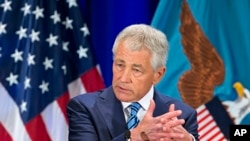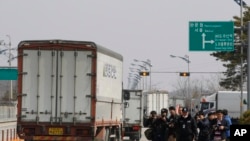SEOUL —
South Korea's defense minister is acknowledging that North Korea has moved a missile, but is downplaying concerns it could be used as part of a threatened attack. Meanwhile, Pyongyang has renewed its warning about the fate of a joint industrial complex with the South, where managers and cargo are being barred for a second day.
South Korea Defense Minister Kim Kwan-jin told lawmakers Thursday North Korea has moved a missile with “considerable range” to the eastern coast of the peninsula. But Kim said it is unlikely it is a new, long-range missile that, if operational, could hit the U.S. mainland.
Kim says the reason for the missile's movement is unknown, but could be for "testing or drills.”
Missile range
Japan's Asahi newspaper reports a U.S. intelligence satellite spotted what appeared to be a long-range KN-08 missile being transported on a train. South Korea's semi-official news agency quoted government sources in Seoul as saying the missile being moved is a Musudan-type medium range missile.
The Musudan (also known as the BM-25) is a 12 to 19 meters long ground-launched missile that can carry a conventional 1,200 kilogram bomb, or could be fitted with a nuclear warhead - something analysts doubt the North could do.
The Musudan has a range of about 3,000 kilometers, meaning it could strike South Korea or Japan.
A statement broadcast by Pyongyang radio Thursday quoted the general staff of North Korea's army as saying the peninsula is “on the eve of explosion” of war between North and South because of U.S. military activities.
The announcer said the White House and Pentagon were formally notified that North Korea will smash what it calls a “steadily mounting hostile” policy and “reckless nuclear threats” by the United States.
The announcer says the North Korean armed forces have been given “final review and approval” to carry out a strike with “miniaturized, lightweight and diversified cutting-edge nuclear” weapons.
North Korea has made similar threats in recent weeks that most analysts have discounted as high-stakes blustering.
US takes threats seriously
U.S. Defense Secretary Chuck Hagel told students at the National Defense University in Washington D.C. Wednesday, the Pentagon takes Pyongyang's threats seriously. He urged North Korea to ratchet down what he called “this very dangerous rhetoric.”
“There is a pathway that's responsible for the North to get on a path to peace, working with their neighbors. There are many, many benefits to their people that could come," said Hagel. "But, they've got to be a responsible member of the world community. And, you don't achieve that responsibility and peace and prosperity by making nuclear threats and taking very provocative actions.”
Hagel says the Pentagon is dispatching an advanced Terminal High Altitude Area Defense missile system to Guam.
The Pacific island, home to U.S. Air Force and Navy bases, is among the locations North Korea has threatened to strike, along with South Korea, Hawaii and the continental United States.
Kaesong
Meanwhile, for a second day, Pyongyang is refusing to allow any South Korean personnel or cargo to enter the Kaesong joint industrial complex, just north of the border separating the two Koreas.
A loudspeaker carried announcements at the border crossing that North Korea has again denied permission for South Korean trucks to drive to the Kaesong factory complex.
South Koreans manage thousands of North Korean workers producing household goods there.
North Korea is threatening to close the facility, even though it is a significant source of hard currency for the impoverished and isolated state.
State media quote an official committee in Pyongyang as saying closure of the Kaesong complex “is set to become a reality” if South Korea's government and conservative media continue their “bad-mouthing.”
A spokesman for the North's Committee for the Peaceful Reunification of Korea (CPRK) says the Kaesong operation, which opened in 2004, “teeters on the brink of collapse.”
South Korea Defense Minister Kim Kwan-jin told lawmakers Thursday North Korea has moved a missile with “considerable range” to the eastern coast of the peninsula. But Kim said it is unlikely it is a new, long-range missile that, if operational, could hit the U.S. mainland.
Kim says the reason for the missile's movement is unknown, but could be for "testing or drills.”
Missile range
Japan's Asahi newspaper reports a U.S. intelligence satellite spotted what appeared to be a long-range KN-08 missile being transported on a train. South Korea's semi-official news agency quoted government sources in Seoul as saying the missile being moved is a Musudan-type medium range missile.
The Musudan (also known as the BM-25) is a 12 to 19 meters long ground-launched missile that can carry a conventional 1,200 kilogram bomb, or could be fitted with a nuclear warhead - something analysts doubt the North could do.
The Musudan has a range of about 3,000 kilometers, meaning it could strike South Korea or Japan.
A statement broadcast by Pyongyang radio Thursday quoted the general staff of North Korea's army as saying the peninsula is “on the eve of explosion” of war between North and South because of U.S. military activities.
Tensions Rising on Korean Peninsula
Tensions Rising on Korean Peninsula- February 12: North Korea carries out third nuclear test
- March 27: North Korea cuts military hotline with South Korea
- March 28: U.S. B-2 bombers fly over Korean peninsula
- March 30: North Korea says it has entered a "state of war" with South Korea
- April 3: North Korea blocks South Korean workers from Kaesong
- April 4: North Korea moves a missile to its east coast
- April 9: North Korea urges foreigners to leave the South. The U.S. and South Korea raise alert level
- April 14: US Secretary of State John Kerry offers talks with Pyongyang if it moves to scrap nuclear weapons
- April 16: North Korea issues threats after anti-Pyongyang protests in Seoul
- April 29: North Korea holds back seven South Koreans at Kaesong
- April 30: North Korea sentences American to 15 years hard labor for hostile acts
- May 20: North Korea fires projectiles for a consecutive third day
- May 24: North Korean envoy wraps up China visit for talks on Korean tensions
- June 7: South Korea accepts Pyongyang's offer of talks on Kaesong and other issues
The announcer says the North Korean armed forces have been given “final review and approval” to carry out a strike with “miniaturized, lightweight and diversified cutting-edge nuclear” weapons.
North Korea has made similar threats in recent weeks that most analysts have discounted as high-stakes blustering.
US takes threats seriously
U.S. Defense Secretary Chuck Hagel told students at the National Defense University in Washington D.C. Wednesday, the Pentagon takes Pyongyang's threats seriously. He urged North Korea to ratchet down what he called “this very dangerous rhetoric.”
“There is a pathway that's responsible for the North to get on a path to peace, working with their neighbors. There are many, many benefits to their people that could come," said Hagel. "But, they've got to be a responsible member of the world community. And, you don't achieve that responsibility and peace and prosperity by making nuclear threats and taking very provocative actions.”
Hagel says the Pentagon is dispatching an advanced Terminal High Altitude Area Defense missile system to Guam.
The Pacific island, home to U.S. Air Force and Navy bases, is among the locations North Korea has threatened to strike, along with South Korea, Hawaii and the continental United States.
Kaesong
Meanwhile, for a second day, Pyongyang is refusing to allow any South Korean personnel or cargo to enter the Kaesong joint industrial complex, just north of the border separating the two Koreas.
A loudspeaker carried announcements at the border crossing that North Korea has again denied permission for South Korean trucks to drive to the Kaesong factory complex.
South Koreans manage thousands of North Korean workers producing household goods there.
North Korea is threatening to close the facility, even though it is a significant source of hard currency for the impoverished and isolated state.
State media quote an official committee in Pyongyang as saying closure of the Kaesong complex “is set to become a reality” if South Korea's government and conservative media continue their “bad-mouthing.”
A spokesman for the North's Committee for the Peaceful Reunification of Korea (CPRK) says the Kaesong operation, which opened in 2004, “teeters on the brink of collapse.”












